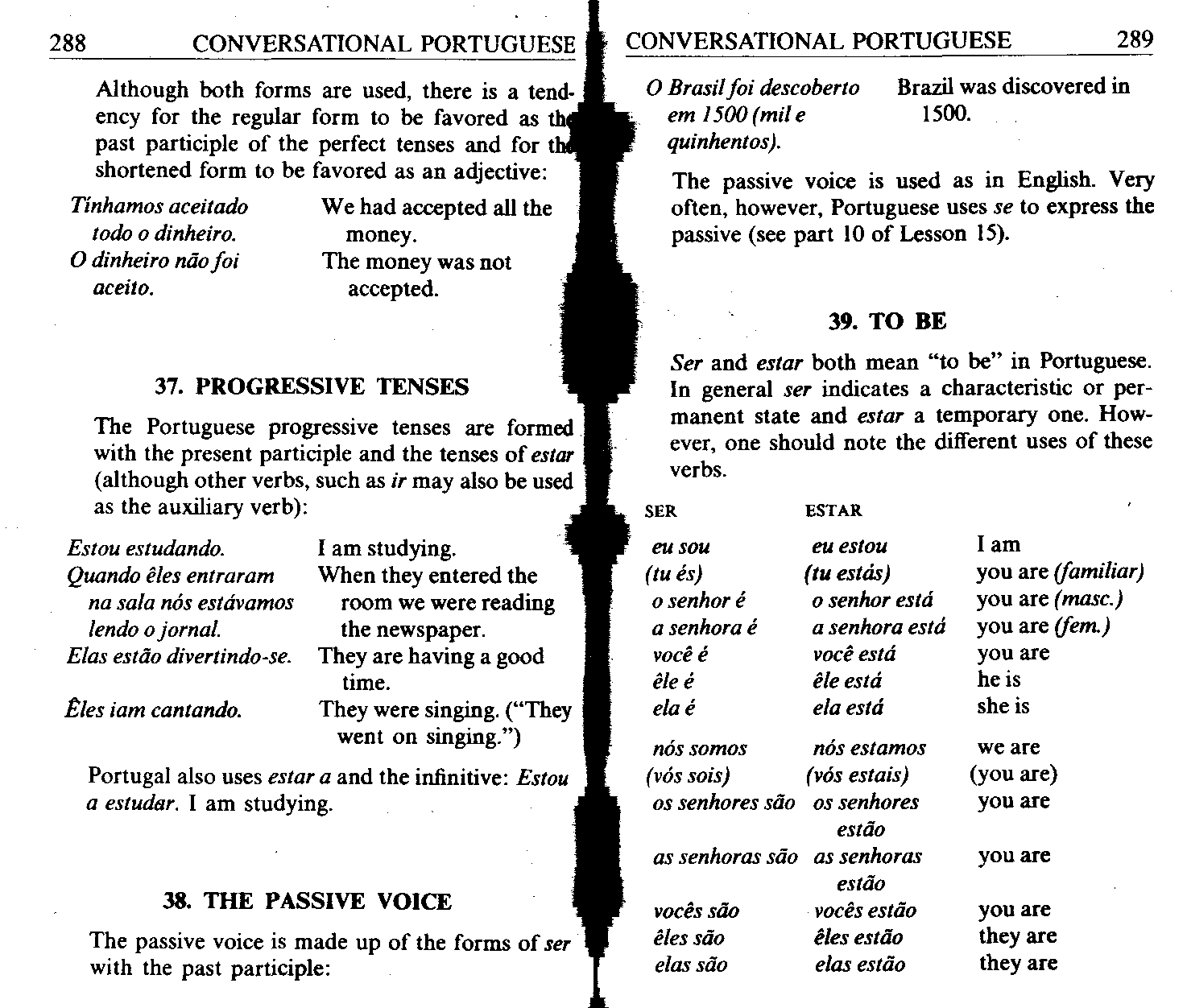Summary p288

288 CONYERSATIONAL PORTUGUESE
Although both forms are used, therc is a tend-ency for the regular form to be favored as past participle of the perfect tenses and for tl shortened form to be favored as an adjective:
Tinhamos aceitado We had accepted all the todo o dinheiro. money.
O dinheiro ndo foi The money was not
aceito. accepted.
37. PROGRESSIVE TENSES
The Portuguese progressive tenses are formed with the present participle and the tenses of estar (although other verbs, such as ir may also be used as the auxiliary verb):
Estou estudando. Quando ełes entraram na sala nós estavamos łendo o jornal.
Elas estdo divertindo-se.
£les iam cantando.
I am studying.
When they entered the room we were reading the newspaper.
They are having a good time.
They were singing. (“They went on singing.”)
Portugal also uses estar a and the iniinitive: Estou a estudar. I am studying.
38. THE PASSIYE VOICE
The passive voice is madę up of the forms of ser with the past participle:
O Brasil foi descoberto Brazil was discovered in
eml500(mile 1500.
ąuinhentos).
The passive voice is used as in English. Very often, however, Portuguese uses se to express the passive (see part 10 of Lesson 15).
39. TO BE
Ser and estar both mean “to be” in Portuguese. In generał ser indicates a characteristic or per-manent state and estar a temporary one. How-ever, one should notę the different uses of these verbs.
|
SER |
ESTAR | |
|
eusou |
eu estou |
I am |
|
(tu es) |
(tu estas) |
you are (famitiar) |
|
osenhore |
o senhor estd |
you are (masc.) |
|
asenhorae |
a senhora estd |
you are (fem.) |
|
voce e |
voce estd |
you are |
|
elee |
ele estd |
he is |
|
elae |
eła estd |
she is |
|
nós somos |
nós estamos |
we are |
|
(vós sois) |
(vós estais) |
(you are) |
|
os senhores sao |
os senhores estao |
you are |
|
as senhoras sao |
assenhoras estao |
you are |
|
voces sao |
voces estao |
you are |
|
eles sao |
ileś estao |
they are |
|
elas sao |
elas estao |
they are |
Wyszukiwarka
Podobne podstrony:
Summary p276 276 CONYERSATIONAL PORTUGUESE £ posshel que ele o faęa. It is possible that he will d
Summary p236 236 CONYERSATIONAL PORTUGUESE De and em combine with the demonstrative forms (see GS2
Summary p248 248 CONYERSATIONAL PORTUGUESE 19. PRONOUNS Pronouns have varying forms depending on w
Summary p300 300 CONYERSATIONAL PORTUGUESE cated, the change given will pertain to those forms of
Summary p302 302 CONYERSATIONAL PORTUGUESE 42. SPELLING CHANGES IN YERBS Some verb forms, as is tr
Summary p222 222 CONYERSATIONAL PORTUGUESE 21. Vamos_(to have dinner). a. jantar
Summary p224 224 CONYERSATIONAL PORTUGUESE (3) variations occur in different areas: a.
Summary p226 226 CONYERSATIONAL PORTUGUESH CONYERSATIONAL PORTUGUESE 227 d g g h j I I Ut m as d i
Summary p230 230 CONYERSATIONAL PORTUGUESE 3, The cedilla (cedilha) is used with
Summary p234 234 CONYERSATIONAL PORTUGUESE k. with parts of the body and articles of clothing inst
Summary p238 238 CONYERSATIONAL PORTUGUESE 13. MASCULINE AND FEMININE 238 CONYERSATIONAL PORTUGUES
Summary p240 240 CONYERSATIONAL PORTUGUESE 14. THE PLURAL 1. Nouns ending in a vowel, including na
Summary p242 242 CONYERSATIONAL PORTUGUESE seu can also be used to translate “his,” “her,” “their.
Summary p246 246 CONYERSATIONAL PORTUGUESE 1«. COMPAR1SON 1. Rcgular comparison facil easy ma
Summary p250 250 CONYERSATIONAL PORTUGUESE CONYERSATIONAL PORTUGUESE_ 251 (te) I
Summary p254 254 CONYERSATIONAL PORTUGUESE Nao me escreva mais. Eles decidiram que nos mandar
Summary p256 256 CONYERSATIONAL PORTUGUESE 21. SOME CONJUNCTIONS ainda que assim que ate
Summary p258 258 CONYERSATIONAL PORTUGUESE 23. ADYERBS 1. Some Portuguese adverbs are formed by ad
Summary p260 260 CONYERSATIONAL PORTUGUESE la (acold) there (morę remote) adiante . forward,
więcej podobnych podstron